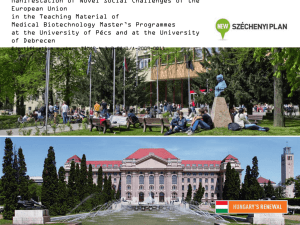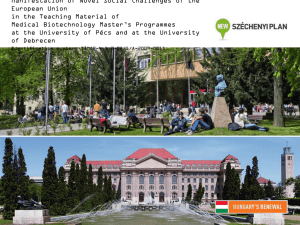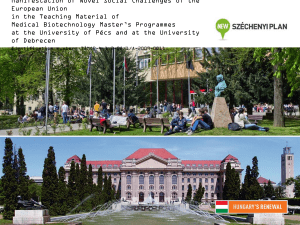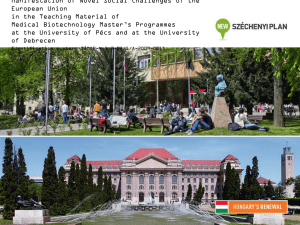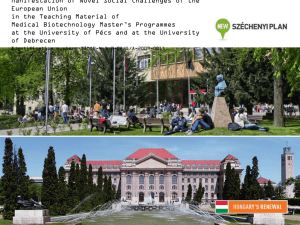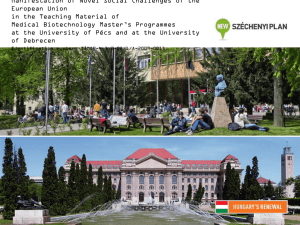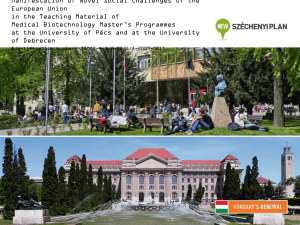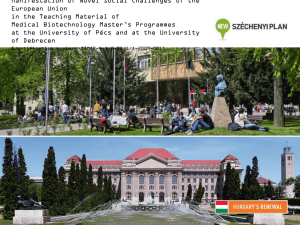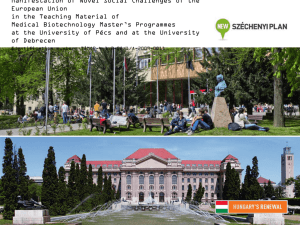1. dia
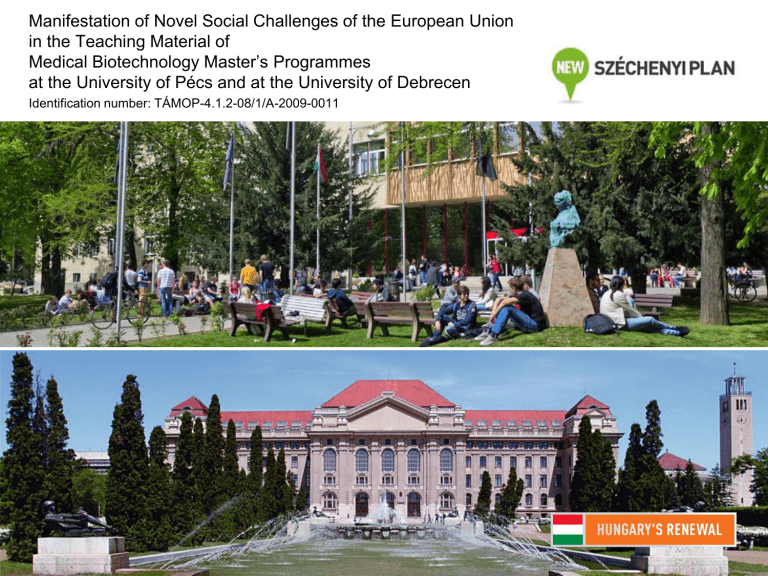
Manifestation of Novel Social Challenges of the European Union in the Teaching Material of
Medical Biotechnology Master’s Programmes at the
University of Pécs and at the University of Debrecen
Identification number : TÁMOP-4.1.2-08/1/A-2009-0011
Manifestation of Novel Social Challenges of the European Union in the Teaching Material of
Medical Biotechnology Master’s Programmes at the
University of Pécs and at the University of Debrecen
Identification number : TÁMOP-4.1.2-08/1/A-2009-0011
Beáta Scholtz
Molecular Therapies- Lecture 3
RECOMBINANT PROTEINS
RECOMBINANT PROTEINS
TÁMOP-4.1.2-08/1/A-2009-0011
The aim of this lecture is to describe the in vitro and in vivo systems utilized for expression of recombinant proteins, and discuss the advantages and disadvantages of these systems. We will also discuss the basics of affinity-tag based protein purification.
1.1 OVERVIEW: PROTEIN PHARMACEUTICALS
1.2 CELL-FREE SYSTEMS: IN VITRO TRANSCRIPTION AND TRANSLATION
1.3 EXPRESSION OF RECOMBINANT PROTEINS IN CELL CULTURE
1.4 NON-PROKARYOTIC EXPRESSION SYSTEMS
1.4.1 Pichia pastoris
1.4.2 Protein expression in insect cells
1.4.3 Mammalian expression systems
1.5 PURIFICATION OF RECOMBINANT PROTEINS
Pure protein preparations
TÁMOP-4.1.2-08/1/A-2009-011
Uses: medicine and research
Sources:
• natural protein mixtures - human/animal/fungi/plant
• artificial preparations - synthetic peptides, recombinant proteins
Protein pharmaceutical
Insulin
Factor VIII
Human growth hormone
Calcitonin
Anti-venom
Natural Source
Pigs or cattle (pancreas)
Human blood (donated)
Human brains
Salmon
Horse or goat blood
4
TÁMOP-4.1.2-08/1/A-2009-011
Equipment used for blood fractionation
5
Antivenom - specific antiserum from goat or horse
TÁMOP-4.1.2-08/1/A-2009-011
B. Rogge Box jellyfish,
Australia
R. Morante
Lonomia caterpillar, Brasil
P-A. Olsson
Black scorpion, Arabia 6
Protein pharmaceuticals
TÁMOP-4.1.2-08/1/A-2009-011
Natural sources are often rare and expensive
Difficult to keep up with demand
Hard to isolate product
May lead to immune reactions (diff. species)
Viral & pathogen contamination
Most protein pharmaceuticals today are produced recombinantly
Cheaper, safer, abundant supply
7
TÁMOP-4.1.2-08/1/A-2009-011
Peptide drugs
Many hormones are actually small peptides (2-40 amino acids)
Calcitonin (32 residues)
Thyroid hormone to enhance bone mass
Oxytocin (9 residues)
Pituitary hormone to stimulate labor
Vasopressin (9 residues)
Pituitary hormone for antidiuretic/vasoconstriction
8
TÁMOP-4.1.2-08/1/A-2009-011
Peptide drugs
Small enough to synthesize using solid phase chemistry (SPPS)
Method developed by Bruce Merrifield in 1960’s (won Nobel prize)
Very efficient synthesis (>99%/couple)
Still: 50 residue peptide, 99% coupling
Yield = 0.99
50 = 60.5%
Technique limited to small peptides
9
TÁMOP-4.1.2-08/1/A-2009-011
Recombinant proteins
Developed in 1970’s &1980’s
Paul Berg (1973) restriction enzymes
Herbert Boyer (1978) cloning human insulin into E. coli –
Genentech
Four general approaches
Expression in cell-free systems
Expression in isolated cells
Expression in transgenic plants/animals
Gene therapy in humans
10
TÁMOP-4.1.2-08/1/A-2009-011
Cell-free systems:
In vitro transcription and translation
• Rapid identification of gene products
• Functional analyses
• Analyze protein-protein interactions
• Study protein folding
• Incorporate modified amino acids for functional studies
• Engineer truncated gene products
11
Cell-free systems:
In vitro transcription and translation
TÁMOP-4.1.2-08/1/A-2009-011
Advantages over in vivo gene expression:
When the protein is: toxic to the host cell insoluble or forms inclusion bodies degraded rapidly by intracellular proteases
Speed and directness of all procedures
Absence of constraints from a living cell
Pure product
Disadvantages over in vivo gene expression:
Lack of cellular membranes
Lack of post translational modifications
12
Components for in vitro transcription
TÁMOP-4.1.2-08/1/A-2009-011
In vivo In vitro
• Linearized DNA template
• Phage RNA polymerase
• 4dNTP
• Buffer
1998 by Alberts, Bray, Johnson, Lewis, Raff, Roberts, Walter.
Published by Garland Publishing.
13
TÁMOP-4.1.2-08/1/A-2009-011
Phage RNA polymerases
Phage Polymerase
T7 RNA polymerase
T3 RNA polymerase
SP6 RNA polymerase
Host of Phage
E. coli
E. coli
Salmonella typhimurium
Promoter Sequence
5’TAATACGACTCACTATAGGG 3’
5’AAATTAACCCTCACTAAAGGG3’
5’AATTTAGGTGACACTATAGAA3’
14
Characteristics of RNA polymerases
TÁMOP-4.1.2-08/1/A-2009-011
RNA polymerases proceed at a much slower rate than DNA polymerases.
RNA pol (50-100 bases/sec)
DNA pol (1000 bases/sec)
The fidelity of RNA synthesis is much lower than that of DNA.
RNA polymerases do not contain proofreading mechanisms.
15
TÁMOP-4.1.2-08/1/A-2009-011
DNA template
Plasmids
Many commonly used cloning vectors contain phage polymerase promoters outside of the multiple cloning site.
PCR Products
Primer must contain promoter
Oligonucleotides
16
TÁMOP-4.1.2-08/1/A-2009-011
Linearization of template
•
Plasmids: no RNA polymerase termination signal; templates are linearized
• PCR template: termination signal in the amplified region OR in the primer
17
Translation in eukaryotic cells
TÁMOP-4.1.2-08/1/A-2009-011
18 1998 by Alberts et al.
Published by Garland Publishing.
Components for in vitro translation
• tRNA & aminoacyl-tRNA synthetases
• Ribosomes
• Amino acids
• ATP, GTP
• Initiation, elongation, and termination factors
• Buffer
• RNA template
TÁMOP-4.1.2-08/1/A-2009-011
Much more complex than transcription
Cannot be mixed from a few isolated components
Always provided as crude extract of cells
19
Common in vitro translation systems
TÁMOP-4.1.2-08/1/A-2009-011
Rabbit reticulocyte lysate
Wheat germ extract
E. coli extract
20
TÁMOP-4.1.2-08/1/A-2009-011
Rabbit reticulocyte lysates
Reticulocytes: immature red blood cells no nuclei (DNA) complete translation machinery, for extensive globin synthesis
Endogenous globin mRNA can be eliminated by incubation with a
Ca 2+ dependent micrococcal nuclease. The nuclease is later inactivated by EGTA.
Low background
Efficient utilization of exogenous RNAs, even at low concentrations
Low nuclease activity
Capable of synthesizing large amounts of full-length products
Capable of translating either capped or uncapped RNAs
21
TÁMOP-4.1.2-08/1/A-2009-011
Wheat germ lysates
Low background incorporation due to low levels of endogenous mRNA
Recommended for translation of RNA containing small fragments of doublestranded RNA or oxidized thiols, which are inhibitory to the rabbit reticulocyte lysate
Generally more cap dependent than reticulocyte systems
Often preferable when synthesizing relatively small proteins (12-15kDa) that comigrate with globin, which is abundant in reticulocyte extracts
22
TÁMOP-4.1.2-08/1/A-2009-011
E. coli lysates
Simple translational apparatus and less complicated initiation control mechanisms
BUT: bacterial extracts contain nucleases that rapidly degrade most exogenous RNAs
Extract must be incubated during preparation so that excess endogenous mRNA is translated and subsequently degraded
The exogenous product is easily identifiable
23
TÁMOP-4.1.2-08/1/A-2009-011
Translation systems
Two approaches to cell free protein synthesis:
Standard translation systems (reticulocyte and wheat extracts) use RNA as a template
Linked or coupled transcription+translation systems start with DNA templates
Important elements for translation:
= Eukaryotic translation signal: 5’-GCC A CCAUG G -3’ “Kozak” sequence, if eukaryotic cell free translation system is used
= Prokaryotic translation signals: 5’-UAAGGAGGUGA-3’ Shine-
Delgarno (SD) , if prokaryotic cell free translation system is used
Linked system: tube 1.=transcription, tube 2.= translation.
= Each can be optimized separately.
Coupled system: both reactions in the same tube
24
TÁMOP-4.1.2-08/1/A-2009-011
Main steps of recombinant protein production
In vivo Cell free
Identification/Isolation of gene of interest
Cloning of gene into plasmid
Plasmid: expression vector
Transformation into host cells
Growth of cells through fermentation
Plasmid: source of DNA template for transcription
In vitro transcription
In vitro translation
Isolation & purification of protein
Formulation of protein product
TÁMOP-4.1.2-08/1/A-2009-011
Recombinant protein expression in cells or organisms
Escherichia coli/ Other bacteria
Pichia pastoris/ Other yeast
Insect cell culture (Baculovirus)
Mammalian cell culture
Plants
Sheep/cows/humans
(transgenics and gene therapy)
26
TÁMOP-4.1.2-08/1/A-2009-011
Expression system selection
Choice depends on size and character of protein
Large proteins (>100 kD)? Choose eukaryote
Small proteins (<30 kD)? Choose prokaryote
High yields, low cost? Choose E. coli
Post-translational modifications essential? Choose yeast, baculovirus or other eukaryote
Glycosylation essential? Choose baculovirus or mammalian cell culture
27
TÁMOP-4.1.2-08/1/A-2009-011
Characteristics of (plasmid) vectors
1. Must be compatible with host cell system (prokaryotic vectors for prokaryotic cells, eukaryotic vectors for eukaryotic cells)
2. Features :
• strong promoter/inducible promoter
• transcription START sequences
• ribosome binding sites
• termination sequences, polyA signal sequence
• affinity tag or solubilization sequences
• multi-enzyme restriction site
• origin of replication (ORI)
• bacterial selectable marker (Amp or Tet)
• eukaryotic selectable marker
• recombination sequences 28 protein expression cloning, plasmid propagation
TÁMOP-4.1.2-08/1/A-2009-011
Promoter selection
• Constitutive
• Inducible
- everywhere, all the time
• Tissue- or developmental stage-specific - selected cell types, specific timing
- specific timing, can avoid toxicity to host
• Synthetic
29
30
TÁMOP-4.1.2-08/1/A-2009-011
TÁMOP-4.1.2-08/1/A-2009-011
Inducible promoters: Tet-off system
31
Inducible promoters: Tet-on system
TÁMOP-4.1.2-08/1/A-2009-011
(faster response)
32
TÁMOP-4.1.2-08/1/A-2009-011
Synthetic promoters, inducible systems
Steroid hormone induction: adenovirus promoter glucocorticoid response element inducer: dexamethasone
Tetracycline operon:
Ecdyson-inducible system:
CMV promoter
Tet operator sequence, Tet repressor protein inducer/repressor: tetracycline requires two vectors
SV40 promoter human RXR receptor and Drosophila ecdyson receptor (VgEcR) = transcription factor heterodimer
Activator of transcription factor: pronasteroneA
Nice dose response
33
TÁMOP-4.1.2-08/1/A-2009-011
Bacterial expression systems
Advantages
Grows quickly (8 hrs to produce protein)
High yields (50-500 mg/L)
Low cost of media (simple media constituents)
Low fermentor costs
Disadvantages
Difficulty expressing large proteins (>50 kD)
No glycosylation or signal peptide removal
Eukaryotic proteins are sometimes toxic
Can’t handle S-S rich proteins
34
TÁMOP-4.1.2-08/1/A-2009-011
Promoter selection for prokaryotes
Promoter type lac promoter trc and tac promoter
T7 RNA polymerase promoter
TetA promoter/operon
Phage promoter pL
PPBAD promoter rhaPBAD promoter
Expression level Regulator/inducer low/middle moderatly high very high
IPTG
IPTG
IPTG middle/high moderatly high low/high low/high tetracycline temperature shift
L-arabinose
L-rhamnose
Main characteristics
Low level intracellular expression
Higher expression
Basal level depends on strain
T7-lac system for tight control
High level induction
Low basal level
Tight regulation
Independent of metabolic state
Very low basal level
Temperature sensitive host needed
Very low basal level
Tight regulation
Fine-tuning, dose dependent
Very low basal level
Tight regulation
35
Cloning & transforming in yeast cells
TÁMOP-4.1.2-08/1/A-2009-011
Pichia pastoris
Saccharomyces cerevisiae
36
TÁMOP-4.1.2-08/1/A-2009-011
Pichia pastoris
Yeast are single celled eukaryotes
Behave like bacteria, but have key advantages of eukaryotes
P. pastoris is a methylotrophic yeast that can use methanol as its sole carbon source (using alcohol oxidase)
Has a very strong promoter for the alcohol oxidase (AOX) gene
(~30% of protein produced when induced)
37
TÁMOP-4.1.2-08/1/A-2009-011
Pichia expression system
Advantages
Grow quickly (8 hrs to produce protein)
Very high yields (50-5000 mg/L)
Low cost of media (simple media constituents)
Low fermentor costs
More advantages
Can express large proteins (>50 kD)
Glycosylation & signal peptide removal
Has chaperonins to help fold “tough” prtns
Can handle S-S rich proteins
38
TÁMOP-4.1.2-08/1/A-2009-011
Pichia pastoris cloning
Uses a special plasmid that works both in E. coli and yeast
Once gene of interest is inserted into this plasmid, it must be linearized
Transfect yeast cells with linear plasmid
Double cross-over recombination event occurs to cause the gene of interest to insert directly into P. pastoris chromosome where the old AOX gene used to be
Now gene of interest is under control of the powerful AOX promoter
Stable transfectant
39
Cloning a gene into Pichia vector
TÁMOP-4.1.2-08/1/A-2009-011
40
TÁMOP-4.1.2-08/1/A-2009-011
Baculovirus/insect cell expression systems
Spodoptera frugiperda
Spodoptera f. larva
Bastiaan (Bart) Drees
Sf9 cells and baculovirus
41
TÁMOP-4.1.2-08/1/A-2009-011
Baculovirus life cycle
2.
3a.
4a.
3b.
4b.
1.
42
TÁMOP-4.1.2-08/1/A-2009-011
Baculovirus life phases in culture
1. Early phase: cell entry, shutting down host gene expression viral protein synthesis
2. Late phase: viral DNS replication, virus assembly, release of viral particles from cell
(peak:18-36 hrs post-infection)
Also used to prepare viral stock
3. Very late phase: polyhedrin and p10 genes are expressed, viruses embedded in polyhedrin form occlusion bodies. Cell lysis.
(24-96 hrs post-infection)
Used for protein production
43
TÁMOP-4.1.2-08/1/A-2009-011
Baculovirus mediated protein expression in insect cells
Autographica californica multiple nuclear polyhedrosis virus (Baculovirus)
Virus commonly infects insects cells of the alfalfa looper (small beetle) or armyworms (and their larvae)
Uses super-strong promoter from the polyhedrin coat protein to enhance expression of proteins while virus resides inside the insect cell - protein is not required for infection or viral life cycle
Secreted proteins better expressed by stably transfected insect cell lines, from the ie-1 promoter
(infection interferes with secretory pathways)
44
TÁMOP-4.1.2-08/1/A-2009-011
Baculovirus expression system workflow
1. Cloning gene of interest into baculovirus genome
2. Use recombinant baculoviral DNA to transfect insect cells
3. Collect viral particles from insect cell culture supernatant
4. Test viral stock titer, freeze stocks
5. Infect new insect cell culture
6. Harvest cells (with occlusion bodies)
Note: not a stable cell line!
45
TÁMOP-4.1.2-08/1/A-2009-011
Cloning a gene into baculovirus (AcMNPV) vector
Site-specific transposition
Transfer vector
5’ x
Cloned gene
3’ x
5’
Cloned gene
3’ modified AcMNPV DNA,
“Bacmid” maintained in E. coli
Recombinant
AcMNPV bacmid
46
TÁMOP-4.1.2-08/1/A-2009-011
Tn7R polyhedrin promoter Gent+ Tn7L
Gene of Interest Transfer vector with insert
PpH
Gene of Interest
Tn7 L
Tn7 R
Bacmid with insert
47
TÁMOP-4.1.2-08/1/A-2009-011
Tn7R GOI Tn7L
Transposition into bacmid
M 13 forward
128bp
Mini att Tn7
145bp
Bacmid DNA
M 13 reverse
48
TÁMOP-4.1.2-08/1/A-2009-011
Baculovirus expression system
Disadvantages Advantages
Grow very slowly (10-12 days for setup)
Cell culture is only sustainable for 4-5 days
Can express large proteins (>50 kD)
(Mostly) Correct glycosylation & signal peptide removal
Has chaperonins to help protein folding
Set-up is time consuming, not as simple as yeast
Very high yields, cheap
49
Baculovirus successes
Alpha and beta interferon
Adenosine deaminase
Erythropoietin
Interleukin 2
Poliovirus proteins
Tissue plasminogen activator (TPA)
TÁMOP-4.1.2-08/1/A-2009-011
50
Mammalian expression systems
TÁMOP-4.1.2-08/1/A-2009-011
51
TÁMOP-4.1.2-08/1/A-2009-011
Mammalian expression systems
Disadvantages Advantages
Selection takes time (weeks for set-up)
Cell culture is only sustainable for limited period of time
Set-up is very time consuming, costly, modest yields
Can express large proteins (>50 kD)
Correct glycosylation & signal peptide removal, generates authentic proteins
Has chaperonins to help protein folding
52
TÁMOP-4.1.2-08/1/A-2009-011
Mammalian expression system
Gene initially cloned into plasmid, and propagated in bacterial cells
Cells are typically derived from the Chinese Hamster Ovary (CHO) cell line
Mammalian cells transformed by electroporation (with linear plasmid) and gene integrates (1 or more times) into random locations within different CHO chromosomes
Multiple rounds of growth and selection using methotrexate to select for those cells with highest expression & integration of DHFR and the gene of interest
Stably transfected cell lines are generated - long term culturing
53
TÁMOP-4.1.2-08/1/A-2009-011
Characteristics of mammalian expression vectors
Recombinant gene expression requires multiple elements in the vector:
• promoter (general or tissue-specific)
• enhancer
• polyA signal
• intron - may enhance expression
• selection marker (ampicylin, neomycin, DHFR etc.)
• Frequently used promoters:
(strong promoters) simian virus 40 (SV40) papovavirus
Rous sarcoma virus human cytomegalovirus (CMV)
54
TÁMOP-4.1.2-08/1/A-2009-011
Methotrexate (MTX) selection
Gene of interest DHFR
Transfect
DHFR minus cells
Grow in nucleoside free medium
Culture a colony of cells
Grow in
0.05 uM Mtx
Culture a colony of cells
55
TÁMOP-4.1.2-08/1/A-2009-011
Methotrexate (MTX) selection
Multiple rounds of selection, increasing MTX concentration
Grow in
0.25 uM Mtx
Culture a
Colony of cells
Grow in
0.5 uM Mtx
Culture a
Colony of cells
Foreign gene expressed at high level in
CHO cells
56
Mammalian cell successes
Factor IX
Factor VIII
Gamma interferon
Interleukin 2
Human growth hormone
Tissue plasminogen activator (TPA)
TÁMOP-4.1.2-08/1/A-2009-011
57
TÁMOP-4.1.2-08/1/A-2009-011
Purification of recombinant proteins
Application
Therapeutic use, in vivo studies
Biochemical assays, X-ray crystallography
N-terminal sequencing, antigen for antibody production, NMR
Required Purity
Extremely high > 99%
High 95-99%
Moderately high < 95%
58
TÁMOP-4.1.2-08/1/A-2009-011
Purification of recombinant proteins
Size
Hydrophobicity
BEHAVIOUR
Charge
Activity
All proteins are different 59
Conventional purification strategy
TÁMOP-4.1.2-08/1/A-2009-011
• Use different properties of protein in purification scheme
• Multiple intermediate steps may be required
• Need to detect low amounts
60
TÁMOP-4.1.2-08/1/A-2009-011
Affinity-tag based purification strategy
• Fusion proteins with affinity tag
• Tag: peptide or protein
• Tag binds something very selectively and w. high affinity
• Very effective purification in initial step
• Tag can be used for detection
• Tag can be cleaved off
61
Affinity-tagging of recombinant proteins
TÁMOP-4.1.2-08/1/A-2009-011 gene for protein of interest insert affinity tag sequence introduce into cells
Purification of tagged protein
Immunolocalization of protein
Other interacting proteins
Tagged protein
62
TÁMOP-4.1.2-08/1/A-2009-011
Histidine tag
His-Ni2+ stable complex at near-neutral aqueous conditions
Solid matrix
Poly-histidine on protein
Nickel ion
(Ni2+)
63
Making proteins bind nickel
TÁMOP-4.1.2-08/1/A-2009-011
64
TÁMOP-4.1.2-08/1/A-2009-011
His-tag based purification strategy
65
His-tag:
T7-tag:
S-tag:
Strep-tag:
Epitope-tags:
TAP-tag:
TÁMOP-4.1.2-08/1/A-2009-011
Examples for affinity and epitope tags
N-or C-terminal 6xHistidin, binds to Ni-resin
• purification starting sequence for T7 gene (11 amino acids)
• enhancer for translation ribonuclease A S-peptid (15 amino acids)
• detection, isolation: biotinylated S-protein, S-protein affinity
C-terminal AWRHPQFGG sequence (affinity to streptavidin) purification recognised by good antibodies (usually monoclonal)
• FLAG-tag ( NYKNNNNK )
• c-myc-tag (
QGKLISGGNL )
„tandem-affinity purification”, calmodulin-binding protein and protein A both fused to protein of interest
• very good system to study protein-protein interactions
66
TÁMOP-4.1.2-08/1/A-2009-011
Fusion proteins in prokaryotic expression systems
Proteins expressed in E. coli are often produced as fusion proteins:
• function of the protein in bacteria is not of interest
• mammalian protein is not expressed effectively by itself
• bacterial fusion partner, (e.g. GST) on the other hand, is expressed effectively – fusion protein is likely to be expressed well, too
• one-step purification from bacterial lysate
67
Bacterial fusion protein systems
TÁMOP-4.1.2-08/1/A-2009-011
Glutathion-S-transferase:
Maltose-binding protein:
Thioredoxin
26 kDa protein
Schistosoma japonica gene product pGEX vector-series fast isolation on glutathion-resin
E. coli malE gene product pMEL vector-series solation on maltose affinity column
17 kDa protein, heat-stable, very good solubility
Ribonucleotide-reductase reducing enzyme
E. coli trxA gene product pTrxFus vector
68
IPTG
TÁMOP-4.1.2-08/1/A-2009-011
Glutathione-S-transferase fusion protein expression system
Polylinker or
Multicloning site
Lac promoter
GST
Repressor protein pGEX
Lac inhibitor gene
Ampicyllin resistance gene
Ori
69
TÁMOP-4.1.2-08/1/A-2009-011
Which tag to use?
Specificity of binding interaction
Cost of resin
Native vs . denaturing elution
Presence of metals
Expression level, solubility & toxicity of target protein
Tag removal
70
Tag removal
NH
2
– tag linker protein
DDDDK protease
TÁMOP-4.1.2-08/1/A-2009-011
Linker/cleavage strategy selection:
• effect on structure
• effect on function
• flexibility
• protein 1 ° sequence
• removal of protease
71
TÁMOP-4.1.2-08/1/A-2009-011
Tag removal
Excision Site Cleavage Enzyme
D-D-D-D-K
X enterokinase
I-D/E-G-R
X factor Xa protease
L-V-P-R
G-S thrombin
E-N-L-Y-F-Q
G TEV protease
L-E-V-L-F-Q
G-P PreScission TM protease
Comment active: pH 4.5-9.5, 4-45 ° C
X cannot be P secondary cleavage sites
X cannot be P/R secondary cleavage sites biotynilated form available secondary cleavage sites active: wide range of T
His-tagged form available engineered with GST tag
72
TÁMOP-4.1.2-08/1/A-2009-011
Purification protocol : as few steps as possible
crude
His-resin I tag cleavage
His-resin II gel filtration
• His-resin I usually provides a major step of the purification
• His-resin II removes cleaved-off
His-tag and persistent contaminant proteins in E.coli
host
• Gel-filtration – “polishing”
Pure protein
73
